Yarrow Water
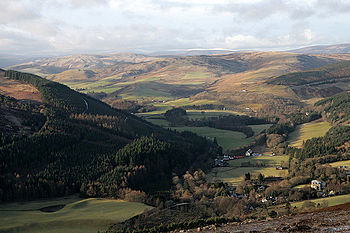
The Yarrow Water is a delightful river in Selkirkshire. It is a tributary of the Ettrick Water, which in turn is a tributary of the Tweed. The Yarrow is renowned for its high quality trout and salmon fishing.[1][2]
The valley of the Yarrow has inspired several well-known songs and poems. Its traditions and folk tales were well documented by Walter Scott, who spent part of his childhood nearby, and in adult life returned to live in the vicinity at Abbotsford House, near Melrose.[3][4]
Name
The name "Yarrow" comes through Old English but may derive from the old British language word garw meaning "rough". It might share a derivation with the town of Jarrow in County Durham.[5][6]
The name is found recorded in old records as Gierua c. 1120, Gierwa and Gieruua c. 1150.
Geography and history
The source of the Yarrow Water is St Mary's Loch on Selkirkshire's border with Peeblesshire and from there the river flows 12 miles in an easterly direction through Selkirkshire (with a fall of fully 405 feet passing such villages as Yarrow Feus, Yarrow and Yarrowford before joining the Ettrick near to the site of the 1645 Battle of Philiphaugh just west of Selkirk. This joining of the waters, which occurs at the eastern edge of the Duke of Buccleuch's Bowhill Estate, is known as the Meetings Pool.[1] The valley is followed by the A708 that runs from Selkirk up to Moffat.
The explorer Mungo Park was born at Foulshiels on the left bank of the river in 1771.[7] In May 1804 Walter Scott came upon Park throwing stones into a deep pool in the river and remarked that "This appears but an idle amusement for one who has seen so much adventure".[2] Park replied that this was "Not so idle perhaps, as you suppose. This was the way I used to ascertain the depth of a river in Africa". Although he had not yet told anyone, Park was considering his second and fateful expedition at the time.[2]
At about the same time, James Hogg ("The Ettrick Shepherd") had come to the attention of Scott whilst the former was working at Blackhouse Farm in the Yarrow valley.[8]
The impressive ruins of Newark Castle, held by Clan Douglas in the 15th century, stand on the right bank of the river opposite Foulshiels.[9]
Poetry and song
The Dowie Dens
The folk song "The Dowie Dens o Yarrow" ("the dismal, narrow wooded valleys of Yarrow") refers to an ambush and murder that takes place in the locality. According to Walter Scott the song is based on a real incident that took place in the seventeenth century, although some modern scholars are sceptical about this story as one of the origins of the song.[10][11]
An adaptation of the old song is found in a poem by William Hamilton of Bangour called "The Braes of Yarrow" first published in Edinburgh in 1724 and said to be "written in imitation of an old Scottish ballad on a similar subject".[12][13]
Outlaw Murray
"The Sang of the Outlaw Murray" is a lay that may have been composed in the reign of James V and which was collected by Walter Scott. Local tradition held that the events took place in the vicinity of Newark Castle, although Scott himself believed that the old tower at Hangingshaw, a seat of the Philiphaugh family near Yarrowford, was the correct location. He was assured by "the late excellent antiquarian Mr. Plummer, sheriff-depute of Selkirkshire... that he remembered the insignia of the unicorns, &c. so often mentioned in the ballad, in existence" there.[14]
William Wordsworth
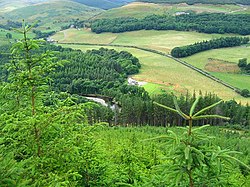
While travelling south from Stirling in 1803, William Wordsworth was told of the beauty of the river, but his party were on the way elsewhere and declined to turn aside to see the Yarrow. The result was a poem published in that year "Yarrow Unvisited " Wordsworth pondered whether the imagination of this river may be better than the reality, and wrote:
Be Yarrow stream unseen, unknown!
It must, or we shall rue it:
We have a vision of our own;
Ah! why should we undo it?
The treasured dreams of times long past,
We'll keep them, winsome Marrow!
For when we'er there, although 'tis fair,
'Twill be another Yarrow!—Yarrow Unvisited, William Wordsworth[15]
In a later visit to the area, William Wordsworth and his sister Dorothy did visit the Yarrow and indeed journeyed down the length of the Yarrow in the company of James Hogg, 'the Ettrick Shepherd'. This was followed by another poem, "Yarrow Visited" in 1814, and later "Yarrow Revisited" in 1838.[2]
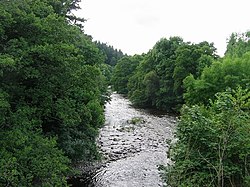
Picking up his earlier theme, Wordsworth writes:
The vapours linger round the Heights,
They melt, and soon must vanish;
One hour is theirs, nor more is mine—
Sad thought, which I would banish,
But that I know, where'er I go,
Thy genuine image, Yarrow!
Will dwell with me—to heighten joy,
And cheer my mind in sorrow.—Yarrow Visited, William Wordsworth[16]
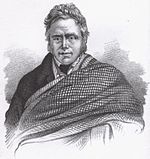
Wordsworth's 1835 "Extempore Effusion upon the Death of James Hogg" includes the lines:
The mighty Minstrel breathes no longer,
'Mid mouldering ruins low he lies;
And death upon the braes of Yarrow,
Has closed the Shepherd-poet's eyes.
Tam Lin
The wood of Carterhaugh near the confluence of the Yarrow and Ettrick, is the setting for the ballad "Tam Lin".[18] This song, collected in 1729, tells the story of a maiden and her relationship to the faery world. It begins:
O I forbid you, maidens a',
That wear gowd on your hair,
To come or gae by Carterhaugh,
For young Tam Lin is there.
There's nane that gaes by Carterhaugh
But they leave him a wad,
Either their rings, or green mantles,
Or else their maidenhead."
It is possible that this tale is derived from the 13th century ballad, "Thomas the Rhymer", that concerns Thomas Learmonth of nearby Erceldoune.[20]
Folk tales
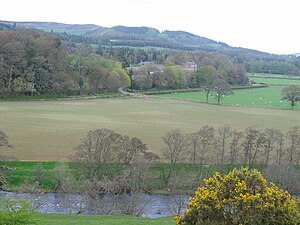
The subject matter of Tam Lin is referred to in various other local traditions. Scott recorded that:
The peasants point out upon the plain [of Caterhaugh], those electrical rings which vulgar credulity supposes to be traces of the Fairy revels. Here, they say, were placed the stands of milk, and of water, in which Tamlane was dipped in order to effect the disenchantment; and upon these spots, according to their mode of expressing themselves, the grass will never grow.[21]
He went on to complain that "in no part of Scotland, indeed, has the belief in Fairies maintained its ground with more pertinacity than in Selkirkshire" and describes a story "implicitly believed by all"[21] said to have occurred in the seventeenth century on Peat Law, to the east of Foulshiels Hill:
The victim of elfin sport was a poor man, who, being employed in pulling heather upon Peatlaw, a hill not far from Carterhaugh, had tired of his labour and laid him down to sleep upon a Fairy ring. When he awakened he was amazed to find himself in the midst of a populous city, to which, as well as to the means of his transportation, he was an utter stranger. His coat was left upon the Peatlaw; and his bonnet, which had fallen off in the course of his aerial journey, was afterwards found hanging upon the steeple of the church of Lanark.[21]
Outside links
| ("Wikimedia Commons" has material about Yarrow Water) |
- Location map: 55°33’11"N, 2°54’47"W
- Map: NT425292
- SCRAN: Yarrow Water, QuickTime VR Panorama
- Gazetteer for Scotland: Yarrow Water
- Wordsworth's Yarrow Unvisited
- Wordsworth's Yarrow Visited
- Wordsworth's Yarrow Revisited
References
- ↑ 1.0 1.1 "Ettrick & Yarrow Fishing" elfisheries.co.uk
- ↑ 2.0 2.1 2.2 2.3 "Ordnance Gazetteer of Scotland: Yair, Yarrow, Yarrow Water"
- ↑ "Sandyknowe and Early Childhood" walterscott.lib.ed.ac.uk. Retrieved 26 July 2009.
- ↑ "Welcome to Abbotsford". scottsabbotsford.co.uk. Retrieved 26 July 2009.
- ↑ Taylor (1921) p. 131. Google Books. Retrieved 25 July 2009.
- ↑ Watson (2004) p. 522 contains the note "Yarrow is Gierua c. 1120, Gierwa, Gieruua c. 1150 (Lawrie). This like Gala, is an English name and may be compared with Jarrow, in Bede 'In Gyruum'."
- ↑ "Foulshiels" Gazetteer for Scotland. The Institute of Geography, University of Edinburgh. Retrieved 25 July 2009.
- ↑ "James Hogg: The Ettrick Shepherd" ettrickyarrow.bordernet.co.uk
- ↑ Coventry (2008) p. 158.
- ↑ Scott (1806) Vol. II "The Dowie Dens of Yarrow" www.humanitiesweb
- ↑ Lloyd (1975) p. 129.
- ↑ Percy (1858) p. 294.
- ↑ Hamilton (1850).
- ↑ Scott (1806) "The Sang of the Outlaw Murray".
- ↑ Yarrow Unvisited, Wm Wordsworth (at The Poetry Foundation)
- ↑ Yarrow Visited, Wm Wordsworth (at The Poetry Foundation)
- ↑ "Extempore Effusion upon the Death of James Hogg" Virginia University. Retrieved 25 July 2009. This eulogy notwithstanding, Wordsworth's notes state "He was undoubtedly a man of original genius, but of coarse manners and low and offensive opinions."
- ↑ "Tam Lin and Carterhaugh, Selkirk" tam-lin.org
- ↑ Tam Lin balladry" tam-lin.org. Retrieved 25 July 2009.
- ↑ "Thomas the Rhymer" in Scott (1806) Part Third.
- ↑ 21.0 21.1 21.2 Scott (1806) "Introduction to the Tale of Tamlane: On the Fairies of Popular Superstition tam-lin.org
- Coventry, Martin (2008) Castles of the Clans. Musselburgh. Goblinshead. ISBN 978-1-899874-36-1
- Hamilton, William (1850) The Poems and Songs of William Hamilton of Bangour. Edinburgh.
- Lloyd, A. L. (1975) Folk Song in England. London. Paladin.
- Percy, Thomas (1858) Reliques of Ancient English Poetry: Consisting of Ballads, Songs, and Other Pieces of Our Earlier Poets. Edinburgh. James Nichol.
- Scott, Sir Walter (1806) The Minstrelsy of the Scottish Border. Gutenberg.org. Melrose.
- Taylor, Isaac (1921) Words & places: illustrations of history, ethnology and geography. Kessinger.
- Watson, W J (2004) The History of the Celtic Place-names of Scotland. First published 1926. Reprinted with an introduction by Simon Taylor. Edinburgh. Birlinn. ISBN 1-84158-323-5
